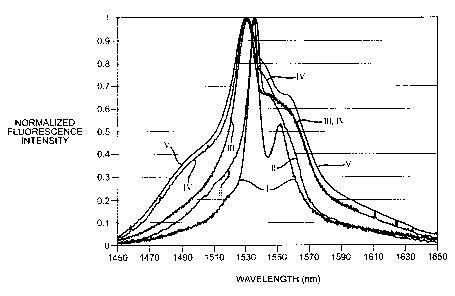Some of the information on this Web page has been provided by external sources. The Government of Canada is not responsible for the accuracy, reliability or currency of the information supplied by external sources. Users wishing to rely upon this information should consult directly with the source of the information. Content provided by external sources is not subject to official languages, privacy and accessibility requirements.
Any discrepancies in the text and image of the Claims and Abstract are due to differing posting times. Text of the Claims and Abstract are posted:
| (12) Patent Application: | (11) CA 2367253 |
|---|---|
| (54) English Title: | SPCVD SILICATE GLASSES |
| (54) French Title: | VERRES AU SILICATE A DEPOT PAR PLASMA EN SURFACE |
| Status: | Deemed Abandoned and Beyond the Period of Reinstatement - Pending Response to Notice of Disregarded Communication |
| (51) International Patent Classification (IPC): |
|
|---|---|
| (72) Inventors : |
|
| (73) Owners : |
|
| (71) Applicants : |
|
| (74) Agent: | GOWLING WLG (CANADA) LLP |
| (74) Associate agent: | |
| (45) Issued: | |
| (86) PCT Filing Date: | 2000-02-11 |
| (87) Open to Public Inspection: | 2000-09-21 |
| Availability of licence: | N/A |
| Dedicated to the Public: | N/A |
| (25) Language of filing: | English |
| Patent Cooperation Treaty (PCT): | Yes |
|---|---|
| (86) PCT Filing Number: | PCT/US2000/003602 |
| (87) International Publication Number: | WO 2000055101 |
| (85) National Entry: | 2001-09-05 |
| (30) Application Priority Data: | ||||||
|---|---|---|---|---|---|---|
|
These glasses incorporate a combination of F and Al2O3 to achieve even wider
fluorescence and improved gain flatness. In addition, SPCVD incorporates large
amounts of N into low-loss fiber whose high charge has an impact on rare earth
behavior. The Surface Plasma Chemical Vapor Deposition (SPCVD) produces fiber
preforms with high levels of F, Al2O3, and N. These heavily fluorinated
glasses provide much broader Er3+ emission than Type I or Type II silica for
enhanced multichannel amplifiers. SPCVD successfully fluorinates silica with
losses below 5 dB/km and increased Er3+ emission width.
Les verres de l'invention contiennent une combinaison de F et Al¿2?O¿3? pour obtenir une fluorescence encore plus large et une meilleure planéité du gain. De plus le dépôt par plasma en surface (SPCVD) comprend de grandes quantités de N dans une fibre à faible perte dont la charge élevée a un impact sur le comportement des terres rares. Le dépôt par plasma en surface (SPCVD) produit des préformes de fibres aux niveaux élevés de F, Al¿2?O¿3? et N. Ces verres fortement fluorés produisent une émission Er?3+¿ beaucoup plus large que la silice de type I ou type II pour des amplificateurs multicanaux perfectionnés. Le SPCVD fluore avec succès la silice avec des pertes inférieures à 5 dB/km et une largeur d'émission Er?3+¿ accrue.
Note: Claims are shown in the official language in which they were submitted.
Note: Descriptions are shown in the official language in which they were submitted.

2024-08-01:As part of the Next Generation Patents (NGP) transition, the Canadian Patents Database (CPD) now contains a more detailed Event History, which replicates the Event Log of our new back-office solution.
Please note that "Inactive:" events refers to events no longer in use in our new back-office solution.
For a clearer understanding of the status of the application/patent presented on this page, the site Disclaimer , as well as the definitions for Patent , Event History , Maintenance Fee and Payment History should be consulted.
| Description | Date |
|---|---|
| Inactive: IPC from MCD | 2006-03-12 |
| Inactive: IPC from MCD | 2006-03-12 |
| Inactive: IPC from MCD | 2006-03-12 |
| Inactive: IPC from MCD | 2006-03-12 |
| Inactive: IPC from MCD | 2006-03-12 |
| Inactive: IPC from MCD | 2006-03-12 |
| Time Limit for Reversal Expired | 2005-02-11 |
| Application Not Reinstated by Deadline | 2005-02-11 |
| Deemed Abandoned - Failure to Respond to Maintenance Fee Notice | 2004-02-11 |
| Letter Sent | 2002-08-23 |
| Inactive: Single transfer | 2002-07-02 |
| Inactive: Cover page published | 2002-02-22 |
| Inactive: Courtesy letter - Evidence | 2002-02-19 |
| Inactive: Notice - National entry - No RFE | 2002-02-18 |
| Application Received - PCT | 2002-02-07 |
| Application Published (Open to Public Inspection) | 2000-09-21 |
| Abandonment Date | Reason | Reinstatement Date |
|---|---|---|
| 2004-02-11 |
The last payment was received on 2003-01-16
Note : If the full payment has not been received on or before the date indicated, a further fee may be required which may be one of the following
Please refer to the CIPO Patent Fees web page to see all current fee amounts.
| Fee Type | Anniversary Year | Due Date | Paid Date |
|---|---|---|---|
| Basic national fee - standard | 2001-09-05 | ||
| Registration of a document | 2001-09-05 | ||
| MF (application, 2nd anniv.) - standard | 02 | 2002-02-11 | 2002-01-14 |
| MF (application, 3rd anniv.) - standard | 03 | 2003-02-11 | 2003-01-16 |
Note: Records showing the ownership history in alphabetical order.
| Current Owners on Record |
|---|
| CORNING INCORPORATED |
| Past Owners on Record |
|---|
| MATTHEW J. DEJNEKA |
| ROSTISLAV KHRAPKO |